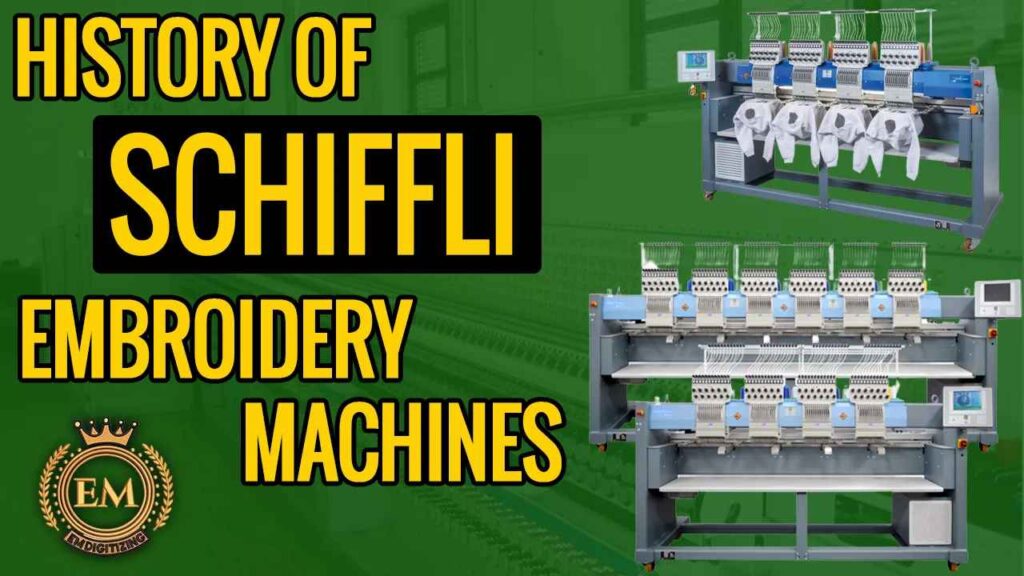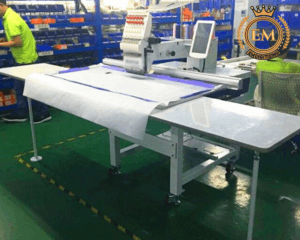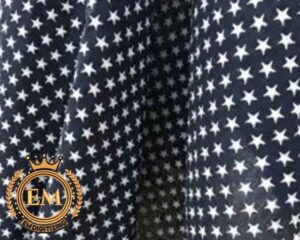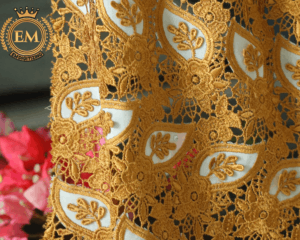History Of Schiffli Embroidery Machines – Explained
Schiffli embroidery machines are specialized machines used for creating intricate embroidery designs on a variety of fabrics. These machines were first invented in the late 19th century by Swiss engineer Isaak Groebli, and their development and evolution have been closely tied to the history of embroidery itself.

Overview Of History Of Schiffli Embroidery Machines:
The original Schiffli embroidery machine was a hand-cranked machine that used a shuttle to create loops of thread on fabric. In the early days of its use, the Schiffli machine was primarily used for creating lace and other delicate fabrics. However, with the introduction of electricity in the early 20th century, the Schiffli machine began to be used for a wider variety of fabrics and embroidery designs.
During the 1920s and 1930s, Schiffli embroidery machines became increasingly popular, as they allowed for mass production of high-quality embroidery designs. This led to the creation of large-scale embroidery factories in Switzerland and other parts of Europe, where the machines were used to produce intricate designs for clothing, linens, and other products.
In the mid-20th century, the development of computerized embroidery machines revolutionized the industry, allowing for even more precise and intricate designs to be created. However, the basic principles of the Schiffli machine are still used in modern embroidery machines, with the addition of computerized controls and advanced stitching technologies.
Today, Schiffli embroidery machines are used by a variety of industries, including fashion, home decor, and automotive manufacturing. They remain an important part of the history and evolution of embroidery, and continue to play a key role in the production of high-quality embroidered products around the world.
How Do Schiffli Embroidery Machines Work?
Schiffli embroidery machines use a combination of mechanical and electronic processes to create intricate embroidery designs on a variety of fabrics. Here is a basic overview of how they work:
Fabric Preparation:

The fabric is first stretched taut on a frame, similar to a quilting hoop, to create a stable surface for embroidery.
Pattern Preparation:

The embroidery design is created in a computer program and then transferred to the machine’s memory or punched onto cards that are read by the machine.
Thread Preparation:

The machine is threaded with multiple spools of thread, which are held on individual creels. The number of spools varies depending on the complexity of the design and the number of colors used.
Stitching Process:
The fabric is moved back and forth under the needle of the machine, while the needle moves up and down to create stitches in the fabric. The needle is controlled by a cam or digital signal, which determines the pattern of the stitches. The thread is fed through the needle and shuttle, which creates loops of thread on the underside of the fabric, while the needle creates stitches on the top.

Repeat Process:
Once the embroidery is complete, the fabric is advanced to the next section of the design, and the process is repeated until the entire design is finished.
The Schiffli embroidery machine can create highly detailed designs with multiple colors and textures, and the machine can be programmed to stitch at high speeds, allowing for mass production of embroidery designs. With advancements in technology, modern Schiffli embroidery machines now use digital programming, computerized controls, and advanced stitching technologies to further improve the speed, accuracy, and efficiency of the embroidery process.
Use Of Schiffli Embroidery Machine In the Textile Industry
Schiffli embroidery machines have been an important part of the textile industry for over a century, and they continue to be used today in a wide range of textile applications. Here are some examples of how Schiffli embroidery machines are used in the textile industry:
Fashion:
Schiffli embroidery machines are used to create intricate embroidery designs on a wide range of fashion products, including dresses, blouses, jackets, and other clothing items. Embroidery is often used to add a decorative element to the garment or to create texture and dimension.
Home Decor:

These machines are used to create embroidery designs on a variety of home decor products, including bedding, curtains, tablecloths, and decorative pillows. Embroidery is often used to add a touch of elegance to these products and to create a custom, high-end look.
Automotive:
They are also used to create embroidery designs on automotive upholstery and other interior components. Embroidery is often used to add a custom look to high-end luxury vehicles.
Industrial:
Schiffli embroidery machines are also used in industrial applications, such as the production of netting, tulle, and other specialized fabrics. These fabrics are often used in the production of clothing, medical supplies, and other products.
The versatility and precision of Schiffli embroidery machines make them an important tool in the textile industry, and their use continues to evolve and expand with new technologies and applications.
Winding Up:
In conclusion, Schiffli embroidery machines have played an important role in the textile industry for over a century, and their use continues to evolve and expand with advancements in technology.
We hope you enjoyed reading this article as we did in writing.
If you want to customize logo embroidery digitizing services, EM DIGITIZING will be your best choice. At EM DIGITIZING, we deliver the best embroidery logo digitizing services with the best quality. We offer 50% off on all our services to our potential customers on their first order. So, get a free quote now and we will get in touch with you.
Hope this article will be helpful for you guys!
If there’s any question related to this article feel free to comment to us. And, thanks for reading!
Schiffli embroidery machines are used in a variety of textile applications, including fashion, home decor, automotive, and industrial uses. They are used to create intricate embroidery designs with multiple colors and textures on a variety of fabrics. The machines use computer programming and mechanical control to produce designs with high accuracy and speed, making them an important tool in the textile industry. Schiffli embroidery machines have contributed to the production of high-quality embroidery designs and have helped to shape the textile industry into what it is today.
The bobbin net is a key component in lace embroidery, as it provides the structure for the lace fabric. It is created by weaving threads onto a mesh net using a series of bobbins. The resulting net can then be used as a base for embroidery and other decorative techniques, such as needle lace or tambour embroidery. The bobbin net provides a stable and durable foundation for creating intricate lace designs.
A Schiffli embroidery machine works by moving a needle and thread in a controlled pattern to create an embroidery design on a fabric. The machine uses a computer program or punched cards to control the needle and thread movement, and can use multiple needles to create designs with multiple colors and textures. The fabric is advanced by the machine, and the stitching process is repeated until the entire design is complete.
